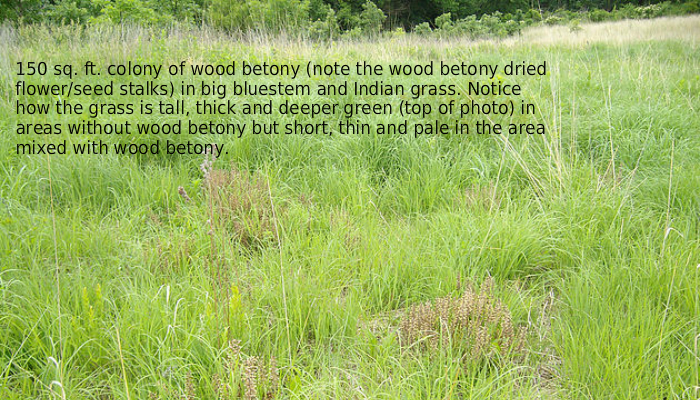What’s the Key to Prairie Diversity?

Scattered patches of blue dot the otherwise expansive green prairie. Curious, I meander over to the nearest blue patch, scanning for plants and critters as I go. Like most “old” prairie plantings, this prairie was seeded with large amounts of tall, warm-season grasses (switch, Indian and big bluestem), and only a few forb (flower) species. As I stroll along, I hope to find native forbs from the additional seeds we’ve added through the years (inter-seeding or over-seeding). The competition from the thick prairie grasses is intense, and the pickings are slim, but a few occasional forb seedlings are present.
Arriving at the blue patch, I marvel at what lies before me. Beautiful clumps of blue-eyed grass intermixed with several other forb species. The thick, warm-season grass carpet in this location has seemingly disappeared. Looking under the blue flowers, I find the cause of this colorful oasis – wood betony!
Wood betony (Pedicularis Canadensis) is a hemiparasitic plant that obtains some nourishment from photosynthesis, but it also takes energy from its host plant. It’s known to parasitize (invest or live on) grasses, reducing their size and vigor, and opening up the thick grass layer to allow room for other plant species. Wood betony likely parasitizes many other species besides grasses. I have seen it parasitize goldenrod species, round-headed bush clover and sedges. Wood betony can form dense colonies. It’s rhizomatous, which means it spreads by underground stems that send up shoots. I believe seed production is critical for this species as individual plants are not long lived.
Wood betony produces spikes of usually yellow flowers in the spring. The flowers are an important early nectar source for pollinators, including queen bumblebees recently emerged from hibernation. Wood betony reduces the height and density of the grasses it parasitizes. This results in plant structural diversity – areas of short, thinly parasitized plants among areas of tall, thick unparasitized plants. In turn, this mosaic of varying plant height and density provides habitat for a greater number of animal species.
The impact of wood betony on plant diversity can be easily observed in some of our best-quality remnants. These remnants support high numbers of plant species, especially spring flora, that are rare or absent from most prairie reconstructions or plantings.
With these positive attributes in mind, I set out in 2006 to see if I could manipulate a prairie planting consisting of high-density, tall, warm-season grasses by introducing wood betony. Not to bore you with the details of my long learning curve, the executive summary is that it works, but the scale of success (in terms of affected area) is small thus far. Out of six initial seeding attempts, only the first one took, and it was severely damaged during the drought of 2012.
Post 2012, the wood betony has recovered well, and I now have a seeding technique that appears to be much more successful establishing wood betony in super-dense, warm-season grasses. I will share this technique once I replicate it a few more times.
Fortunately, today, there are restoration practitioners planting more highly diverse prairies. However, due to resource limitations, many prairies are still planted with very few plant species. In addition, older planted prairies are still grass dominated decades later. As practitioners working to save, and hopefully expand, the last tiny fragments of an endangered ecosystem – the tallgrass prairie, how do we expand biodiversity capacity in the lands we manage? And how do we do this in a sustainable manner with as little human tinkering as possible?
I believe some of the answers will come from our increased understanding of how different plant species interact. Plant species that have lived side by side since the beginning of prairies, doing what they have always done – battling for dominance in a wave of assaults, counter assaults, and counter-counter assaults, resulting in no long-term dominance by any individual species.
And maybe, just maybe, there are certain species, like wood betony, that hold the key for the pathway to diversity?
Originally published on Environmental Returns
Tags: David Cordray, native prairie, species diversity

